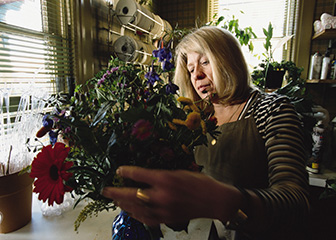Finding a Qualified Resume Writer for a...
|
| Resume Writers... | Thumbnail Review... |
|
www.resumewriters.com | Reasonable pricing, standout writing, and an interview guarantee from the largest network of resume writers on the Internet (representing more than 5 dozen career fields and industries). The BBB gives them an A+ rating. |
|
|
www.greatresumesfast.com | Pricey, yes. But writing is "top shelf" from a team of HR Execs, Hiring Managers and former Recruiters, each detailed on the company's website. Expect an hour-long consultative phone session with your writer. Guaranteed interviews. The BBB gives them an A+. |
Considering a Career Move into Floral Design?
If you're considering a move into floral design from either a closely related field or from a totally unrelated profession, you'll be looking for a transitional resume -- and a talented resume writer to handle the assignment. Transitional resumes are some of the most difficult resume projects as they require a writer knowledgeable in at least two professions -- and the ability to identify transferable skills from one to the other.
Before you hand off that resume assignment, make sure you know enough about the job of a Florist to... a) really want it, and b) be able to step up to the plate. Here's a quick overview (more information at Wikipedia - Floral Design):
 |
What You'll Do: Floral designers typically have a wide range of tasks that must be completed daily. True florists grow their own plants from seeds. They carefully nurse the flowering plants to maturity by ensuring that they get quality soil, food, water, and sunlight. Only the greatest amount of care combined with know-how can produce big, beautiful flowers. Many florists, however, order pre-grown flowers from suppliers all around the world. These flowers must also be nursed to maturity, but they usually require less time and effort because they are already budding plants. In addition to knowing how to care for flowering plants, florists also need to know a lot about them in general. Some common knowledge that all florists should have include: how to identify various flower types based on characteristics like shape and color, knowing which flowers are in season and their general durations of availability, knowing the properties and needs of different flowers, and more. Having in-depth knowledge about flowers will help with making appropriate recommendations, giving good care tips, and keeping the flowers and their owners safe. In addition to having technical skills and knowledge, florists need to be creative and artistic in order to build custom creations for customers and special events like weddings, graduation parties, funerals, and birthday parties. Many floral designers work closely with interior designers or landscapers to make the world around us more attractive and inviting. Self-employed florists who run small shops may be involved in all aspects of the business. You'll likely spend most of your workday in a retail location such as a grocery store, department store, or specialty flower shop caring for the plants, maintaining the space, and tending to customers in person and over the phone. The work environment is typically pretty comfortable and calm, but things can get hectic during certain times of the year, especially around the holidays. Working with perishable goods is also stressful because you can easily damage or destroy flowering plants that are fragile or have very specific nursing needs. Like most florists, you'll probably work full-time hours that are fairly regular. You may be assigned extended hours around holidays and other special occasions. |
 |
Education and Training: Most florists get on-the-job training under more experienced workers. There are no educational requirements for becoming a florist, but some individuals have degrees or certificates in fields like floral design, biology, or botany. If you want to be perceived as knowledgeable, competent, and professional, the AIFD offers certification. |
 |
The Future: The floral design profession is expected to decline at about 9% through 2020, with the biggest decline -- 29% -- taking place in florist shops (while increasing 8% in grocery stores). |
 |
The Pay: Annual salaries for Florists and Floral Designers in the U.S. range from $16,900 to $35,800, with the average median annual wage hitting $23,800 in 2012 as per the U.S. Bureau of Labor Statistics. |
Still interested in pursuing a position in floral design? Got the qualifications? Great. The next step is to choose a qualified resume writer. Treat the coming job search like the business it is, and you'll do fine.
Best of luck,
David Alan Carter, OccupationalResumes.com

Tag or bookmark under:
Floral Designer Resume | Floral Design Occupation | Resume Writing Services for Florists and Floral
Designers
_____
NOTE: This website
is monetized through the use of Affiliate Programs with the online providers we review. Read our Disclosure Statement for more information on our Affiliate
Relationships.
|



 Back To
Top
Back To
Top Facebook
Facebook Twitter
Twitter